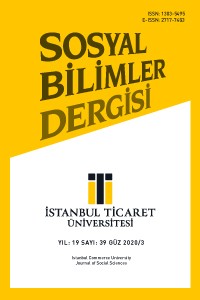Öz
Bu çalışma genel hatlarıyla liderlik kavramını açıklamakta, liderlik tiplerinin değişimini belirtmekte ve NATO örneği üzerinden uluslararası örgütlerdeki liderlik pozisyonunu tartışmaya açmaktadır. Liderlik kavramının özelliklerini ve çeşitlerini açıkladıktan sonra uluslararası örgütlerin uluslararası sistem içerisindeki yerini de açıklayan bu çalışma, NATO örneğinden yola çıkarak uluslararası örgütler içerisindeki liderlik yapısını incelemektedir. Genellikle Genel Sekreterlik şeklinde karşımıza çıkan uluslararası örgütlerdeki liderlik pozisyonunun ne kadar etkili olduğu tartışılmaktadır. NATO’nun örgüt yapısı açıklandıktan sonra Genel Sekreterin görev ve yetkileri incelenmekte ve ortaya konan liderlik tiplerinden hangisine daha uygun olduğu belirtilmektedir.
Anahtar Kelimeler
Kaynakça
- Agence Europe. (2020). Mr Stoltenberg announces appointment of group of experts. Erişim Tarihi: 02.04.2020, Agence Europe: https://agenceurope.eu/en/bulletin/article/12458/20
- Ashworth, R., Boyne, G., & Delbridge, R. (2007). Escape From the Iron Cage? Organizational Change and Isomorphic Pressures in the Public Sector. Journal of Public Administration Research and Theory, 19(1), 165–187.
- Avolio, B. J., & Gardner, W. L. (2005). Authentic leadership development: Getting to the root of positive forms of leadership. The Leadership Quarterly, 16(3), 315-338.
- Barbuto Jr, J. E., & Wheeler, D. W. (2006). Scale development and construct clarification of servant leadership. Group & Organization Management, 31(3), 300-326.
- Biermann, F., & Siebenhüner, B. (Eds.). (2009). Managers of Global Change. London: The MIT Press.
- Carsten, M. K., Uhl-Bien, M., West, B. J., Patera, J. L., & McGregor, R. (2010). Exploring social constructions of followership: A qualitative study. The Leadership Quarterly, 21, 543-562.
- Claude Jr., I. L. (1988). Swords Into Plowshares: The Problems and Progress of International Organization (4th ed.). New York: Random House.
- DiMaggio, P. J., & Powell, W. W. (1983). The Iron Cage Revisited: Institutional Isomorphism and Collective Rationality in Organizational Fields. American Sociological Review, 48(2), 147-160.
- Fry, L. W. (2003). Toward a Theory of Spiritual Leadership. The Leadership Quarterly, 14(6), 693-727.
- Greenwood, R., Oliver, C., Lawrence, T. B., & Meyer, R. E. (2008). Introduction. G. R., O. C., L. T. B., & M. R. E. (Eds.), içinde The SAGE Handbook of Organizational Institutionalism (ss. 1-46). London: SAGE Publications.
- Hendrickson, R. (2004). Leadership at NATO: Secretary General Manfred Woerner and the Crisis in Bosnia. Journal of Strategic Studies, 27(3), 508-527.
- Kellerman, B. (2004). Leadership: Warts and All. Harvard Business Review, 82(1), 40-45.
- Keohane, R. O. (1998). International institutions: Can interdependence work? Foreign Policy (110), 82-96.
- Koremenos, B., Lipson, C., & Duncan, S. (2001). The Rational Design of Internaitonal Institutions. International Organization, 55(4), 761-799.
- McCormick, J. (1999). The European Union: Politics and Policies. . Boulder Colorado: Westview Press.
- Mearsheimer, J. J. (1994-1995). The False Promise of International Institutions. International Security, 19(3), 5-49.
- Mearsheimer, J. J. (2001). The Tragedy of Great Power Politics. New York and London: W. W. Norton & Company.
- Milner, H. (1991). The Assumption of Anarchy in International Relations Theory: A Critique. Review of International Studies , 17(1), 67-85.
- NATO. Collective defence - Article 5. Erişim Tarihi: 27.03.2020, NATO: https://www.nato.int/cps/en/natohq/topics_110496.htm
- NATO. Consensus decision-making at NATO. Erişim Tarihi: 30.03.2020, NATO: https://www.nato.int/cps/en/natolive/topics_49178.htm
- NATO. What is NATO? Erişim Tarihi: 01.04.2020, NATO: https://www.nato.int/nato-welcome/index.html
- Ness, G. D., & Brechin, S. R. (1988). Bridging the Gap: International Organizations as Organizations. International Organization, 42(2), 245-273.
- North, D. C. (1990). Institutions, Institutional Change and Economic Performance. Cambridge: Cambridge University Press.
- Northouse, P. G. (2018). Leadership: Theory and Practive (7th ed.). New York: SAGE Publications.
- Reinalda, B., & Verbeek, B. (2014). Leadership of International Organizations. In R. A. Rhodes, & P. 'T Hart (Eds.), The Oxford Handbook of Political Leadership. Oxford: Oxford University Press.
- Shiraev B., E., & Zubok, V. M. (2015). International Relations. New York: Oxford University Presses.
- Walt, S. M. (1998). International Relations: One World, Many Theories. Foreign Policy(110), 29-46.
- Waltz, K. N. (1988). The Origins of War in Neorealist Theory. The Journal of Interdisciplinary History, 18(4), 615-628.
- Waltz, K. N. (2010). Theory of International Politics. Long Grove: Waveland Press.
- Wendt, A. (1992). Anarchy is what States Make of It: the Social Construction of Power Politics. International Organization, 46(2), 391-425.
- Yukl, G., & Mahsud, R. (2010). Why flexible and adaptive leadership is essential. Consulting Psychology Journal: practice and research, 62(2), 81-93.
Ayrıntılar
| Birincil Dil | Türkçe |
|---|---|
| Bölüm | Derlemeler |
| Yazarlar | |
| Yayımlanma Tarihi | 27 Aralık 2020 |
| Gönderilme Tarihi | 5 Temmuz 2020 |
| Kabul Tarihi | 29 Ekim 2020 |
| Yayımlandığı Sayı | Yıl 2020 Cilt: 19 Sayı: 39 |



